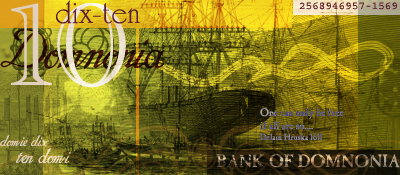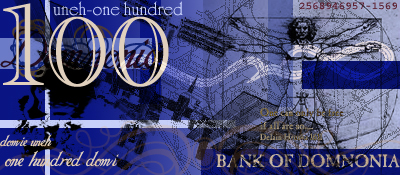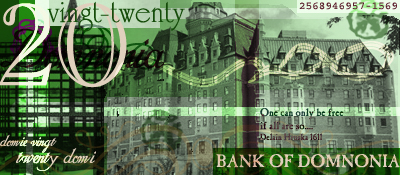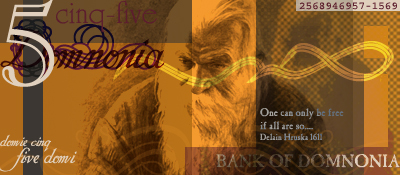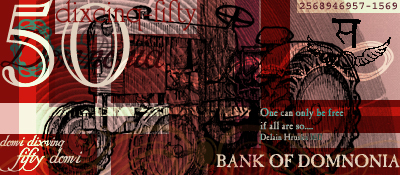Domi

| |
| Units | 1/100, 10/100, 50/100, 1, 5, 10, 20, 50, 100 |
|---|---|
| Symbol | Ð |
| Currency Code | DODO
|
| Exchange Rate to Verino | 1.00Ð = 0.37◊ |
The Domi is a unit of currency used in Domnonia, Hiel and Silures.
Contents
The Domi
The Domi (currency code DODO) has been the currency of Domnonia since 1888. It is normally abbreviated with the Domi sign Ð, or ÐO to distinguish it from other currencies with the Domi name. It is divided into 100 cents. The Domi is the monetary basis for the Domini economy, with all coins minted by the Asymetrical Domini Mint and all banknotes printed by the Bank of Domnonia.
The Keesland Polar Crown
The first monetary denominations used in Domnonia were the Keesland Crown(‡); eight unit coins issued by Keesland and her colonies. Because the colonies used the ‡OD system for accounting (see Old Domini Trade), it was necessary to set a valuation or rating for the Crown in ‡OD. Different ratings were used in the different regions. The Hiel rating was introduced c.1802 and was the most commonly used in the western colonies of the Eastern Keeslands. It valued the Crown at 5‡OD (the value of the silver in the coin was in fact only equal to 4‡OD).
Discriminatory Practices
After union of east and western Domnonia, Sendarese immigrants, settling in the Cadorn region (Lindinis), brought the Sendar rating (named after their former Kingdom) of ‡1 = 8‡OD. This practice saw foreigners settling in the region with a huge advantage over the indiginous population. This was officially outlawed (in favour of the Hiel rating, which still discriminated against natives) in 1836 but continued to be used until the Domi was established.
Historic Issues
During this period, many local banknotes were issued denominated in ‡, ‡OD, or both. The Bank of Cadorn issued notes denominated in ‡OD in 1817, whereas the Hiel and Algar colonies, with stronger ties to Keesland and weaker ones to the Domini, preferred the ‡ system. Some ‡OD denominated banknotes bore a depiction of the Keesland Crown(s) they were equal to. However, few coins were issued, as the Keeslandic authorities were unwilling to allow the colonies to mint their own coins. Various different bank tokens were issued in denominations of ½½1‡ and ½1‡ crown.
The Modern Domi
The Federation of Domnonia declared that all accounts would be kept in Domi and ÏDomi as of January 1, 1888, and ordered the issue of the first official Domini coins in the same year. The colonies and states that came together in the Domini Confederation progressively adopted a decimal system over the next few years, eliminating the ÏÐ. Whilst Tomar adopted a dollar equivalent to the Domi (see Tomar Domi), and Cadorn continued issuing a city-state currency(see Bank of Cadorn)and the Silures Territories were not yet part of Confederation. Tomar and Cadorn retained their own currency until 1971, whilst Silures issued its own currency until joining the Confederation in 2005.
Finally, the Federal Parliament passed the Single Currency Act in June 1971, tying up loose ends as to the currencies of Tomar and the City of Cadorn and replacing them with a common Domi.
Prior to the establishment of the Bank of Domnonia in 1935, Domini banknotes were issued primarily by chartered banks, with the federal government issuing banknotes in smaller denominations never to exceed five Domi.
The Post-Modern Domi
In 2005, as part of its ongoing efforts to improve the security of Domnini bank notes, the Bank of Domnonia issued new 5, 10, 20, and 50Ð notes with upgraded security features.
The upgraded notes included the same security features found on the 100Ð Domini Journey series note issued in 2004. The improved features included a metallic holographic symbol on the right center of every note, a watermark portrait, a windowed colour-shifting thread woven into the paper, a see-through number, and enhanced fluorescence under ultraviolet lighting. These features are reliable and quick and easy to use, and were designed to help Domini protect themselves from accepting counterfeit notes. The themes on the front and back of the notes were the same as those issued in 2004, but with new illustrations.
Imagery
| Unit (DODO) | Obverse | Reverse |
|---|---|---|
| Banknotes | ||
| 1Đ | Domini Owl | Hiel Range landscape Painting |
| 5Đ | Delain Hruska, Father of Confederation | Imprint of Constitution |
| 10Đ | The Inlad Schooner | Flag of Jonquiere-Tadoussac |
| 20Đ | Parliament Buildings | Flag of Keeslandia |
| 50Đ | Tractor | Wheat field landscape painting |
| 100Đ | Da Vinci's Man, Satelite | Flags of The IDU and Domnonia |
